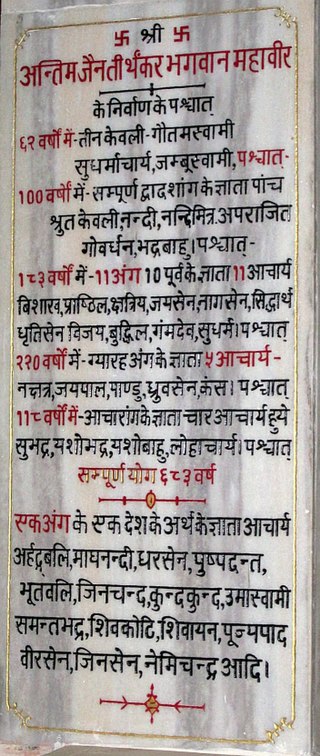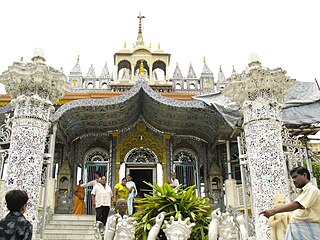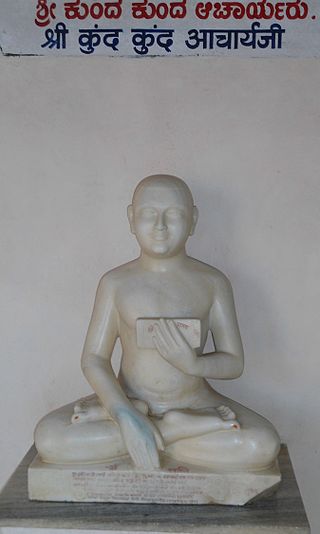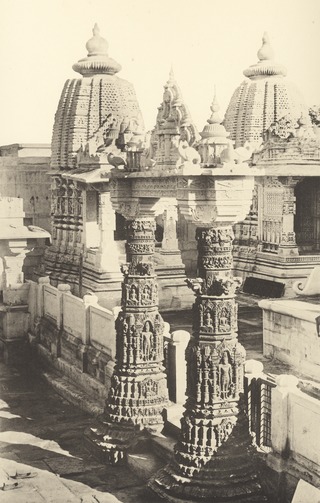
Mahavira, also known as Vardhamana, was the 24th Tirthankara of Jainism. He was the spiritual successor of the 23rd Tirthankara Parshvanatha. Mahavira was born in the early 6th century BCE to a royal Kshatriya Jain family of ancient India. His mother's name was Trishala and his father's name was Siddhartha. According to the second chapter of the Śvētāmbara Ācārāṅga Sūtra, Siddhartha and his family were devotees of Parshvanatha. Mahavira abandoned all worldly possessions at the age of about 30 and left home in pursuit of spiritual awakening, becoming an ascetic. Mahavira practiced intense meditation and severe austerities for twelve and a half years, after which he attained Kevala Jnana (omniscience). He preached for 30 years and attained moksha (liberation) in the 6th century BCE, although the year varies by sect.

The Śvetāmbara is one of the two main branches of Jainism, the other being the Digambara. Śvetāmbara in Sanskrit means "white-clad", and refers to its ascetics' practice of wearing white clothes, which sets it apart from the Digambara or "sky-clad" Jains whose ascetic practitioners go nude. Śvetāmbaras do not believe that ascetics must practice nudity.

Parshvanatha, or Pārśva and Pārasanātha, was the 23rd of 24 Tirthankaras of Jainism. Parshvanatha is one of the earliest Tirthankara who is acknowledged as a historical figure. The Jain sources place him between the 9th and 8th centuries BCE whereas historians consider that he lived in the 8th and 7th century BCE.

Buddhism and Jainism are two Indian religions that developed in Magadha (Bihar) and continue to thrive in the modern age. Gautam Buddha and Mahavira are generally accepted as contemporaries. Jainism and Buddhism share many features, terminology and ethical principles, but emphasize them differently. Both are śramaṇa ascetic traditions that believe it is possible to attain liberation from the cycle of rebirths and deaths (samsara) through spiritual and ethical disciplines. They differ in some core doctrines such as those on asceticism, Middle Way versus Anekantavada, and self versus non-self.
The Oswal are a Śvetāmbara Jain-majority Baniya community with origins in Osian, a town in the Marwar region of Rajasthan, India. They claim to be of Rajput descent. The Osavālas origin legend has multiple aspects, all of which include a fierce, meat-eating goddess who becomes pacified by a Jain ascetic, involving the conversion of a king to Jainism. In modern times, there are barely any Osavālas living in Osiyān, but they still regard the Mahavira temple and Sachiya Mata Temple as their "mother temples". They reside in Rajasthan, Malwa, Gujarat, and Kutch.

Porwal, also known as Poravāḍa or Prāgvata, is a Kshatriya community that originated in southern Rajasthan, India. They are mainly of Jain or Hindu faith. The name Porwal was applied on the basis of the names of other Bania communities.

Jainism is a religion founded in ancient India. Jains trace their history through twenty-four tirthankara and revere Rishabhanatha as the first tirthankara. The last two tirthankara, the 23rd tirthankara Parshvanatha and the 24th tirthankara Mahavira are considered historical figures. According to Jain texts, the 22nd tirthankara Neminatha lived about 84,000 years ago and was the cousin of Krishna.

A Pattavali, Sthaviravali or Theravali, is a record of a spiritual lineage of heads of monastic orders. They are thus spiritual genealogies. It is generally presumed that two successive names are teacher and pupil. The term is applicable for all Indian religions, but is generally used for Jain monastic orders.

Sthulabhadra was a Jain monk who lived during the 3rd or 4th century BC. He was a disciple of Bhadrabahu and Sambhutavijaya. His father was Sakatala, a minister in Nanda kingdom before the arrival of Chandragupta Maurya. When his brother became the chief minister of the kingdom, Sthulabhadra became a Jain monk and succeeded Bhadrabahu in the Pattavali as per the writings of the Kalpa Sūtra. He is mentioned in the 12th-century Jain text Parisistaparvan by Hemachandra.

Shrimal (Srimal) Jain is an ancient Jain and Hindu community originally from Rajasthan, Shrimal or Bhinmal town in southern Rajasthan. They were traditionally wealthy merchants and money lenders and were prominent at the court of Rajput kings as treasurers and ministers, holding the titles of Dewan or Durbari. This caste is claimed to descend from the Goddess Lakshmi and their descendants are well known for business acumen and are in possession of Havelis and mansions given to them as gifts from kings for their service as royal treasurers, ministers, courtiers and advisors. The Shrimal (Srimal) Jain are thought to be the highest gotra in the Oswal merchant and minister caste that is found primarily in the north of India.

Gautama Swami, born as Indrabhuti Gautama was the first Ganadhara of Mahavira, the 24th and last Jain Tirthankara of present half cycle of time. He is also referred to as Guru Gautama, Gautama Ganadhara, and Ganadhara Gautama Swami.

Digambara is one of the two major schools of Jainism, the other being Śvetāmbara (white-clad). The Sanskrit word Digambara means "sky-clad", referring to their traditional monastic practice of neither possessing nor wearing any clothes.

Jainism is an Indian religion which is traditionally believed to be propagated by twenty-four spiritual teachers known as tirthankara. Broadly, Jainism is divided into two major schools of thought, Digambara and Śvetāmbara. These are further divided into different sub-sects and traditions. While there are differences in practices, the core philosophy and main principles of each sect is the same.
Gaccha, alternatively spelled as Gachchha, is a monastic order, along with lay followers, of the image worshipping Murtipujaka Śvetāmbara sect of Jainism.

The Mahavira Jain temple is built in Osian of Jodhpur District, Rajasthan. The temple is an important pilgrimage of the Oswal Jain community. This temple is the oldest surviving Jain temple in Western India and was built in 457 BC.

Daulatsagarsuri was a Jain ascetic, philosopher, and a revered saint belonging to the Śvetāmbara sect. He was the head of the monastic order (Gacchadhipati) of the "Sagar Samudaay" of the Tapa Gaccha. While he was alive, he was the preceptor of 900 monks and nuns. He was awarded the rarest of the rare and ancient title of "Shri Sangh Sthavir" based on his austerity, knowledge of the canonical scriptures of Jainism, and spiritual leadership, becoming the only second of the modern Jain ascetics to have achieved this feat.
Swayamprabhasuri or Svayamprabhasuri was a Śvetāmbara Jain ascetic and the 5th successor in the lineage of the monastic heads of the Chaturvidha Sangha's Upkeśa Gaccha. He succeeded Keśiśramanācharya and is believed to have existed in 6th–5th century BC. He is known for establishing the Śrīmali and Porvāl clans.

Ratnaprabhasuri was a Śvetāmbara Jain ascetic and the 6th successor in the lineage of the monastic heads of the Chaturvidha Sangha's Upkeśa Gaccha. He succeeded Swayamprabhasuri and is believed to have existed in 6th–5th century BC. He is most well-known as the founder of the Oswāl clan of Śvetāmbara Jains.
Upkeśa Gaccha is the oldest gaccha of Śvetāmbara Jainism. It is one of the 84 gacchas of the Śvetāmbara sect that were once in existence. Unlike most other gacchas that follow Mahavira's lineage and begin with his disciple Sudharmaswami, it follows the lineage of the 23rd Tirthankara Parshvanatha and is said to have begun with his prime disciple Ganadhara Shubhadatta. It went extinct in about 1930 CE.















